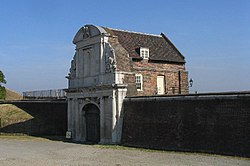Tilbury Fort
| Tilbury Fort | |
|---|---|
| Tilbury, Essex | |

The Water Gate of Tilbury fort
|
|
| Coordinates | 51°27′09″N 0°22′25″E / 51.45238°N 0.37357°E |
| Type | Artillery fort |
| Site information | |
| Owner | English Heritage |
| Open to the public |
Yes |
| Condition | Intact |
Tilbury Fort, also known historically as the Thermitage Bulwark and the West Tilbury Blockhouse, is an artillery fort on the north bank of the River Thames in England. The earliest version of the fort, comprising a small blockhouse with artillery covering the river, was constructed by King Henry VIII to protect London against attack from France as part of his Device programme. It was reinforced during the 1588 Spanish Armada invasion scare, after which it was reinforced with earthwork bastion, and Parliamentary forces used it to help secure the capital during the English Civil War of the 1640s. Following naval raids during the Anglo-Dutch Wars, the fort was enlarged by Sir Bernard de Gomme from 1670 onwards to form a star-shaped defensive work, with angular bastions, water-filled moats and two lines of guns facing onto the river.
In addition to protecting the Thames, in the 18th century Tilbury also began to be used a transit depot and for storing gunpowder. It continued to be essential for the defence of the capital and a new artillery battery was added in the south-east corner during the Napoleonic Wars. The fort became increasingly less significant as a defensive structure, however, as military technology developed in the 19th century. It was redeveloped to hold heavy artillery after 1868, providing a second-line of defence along the river, but further changes in technology meant that it had become obsolete by the end of the century. Instead Tilbury became a strategic depot, forming a logistical hub for storing and moving troops and materiel throughout the First World War. The fort had only a limited role in the Second World War and was demobilised in 1950.
...
Wikipedia

